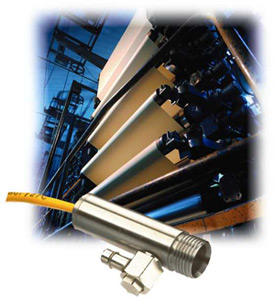[vc_row][vc_column][vc_column_text] Infrared temperature sensors sense electromagnetic waves in the 700 nm to 14,000 nm range. While the infrared spectrum extends up to 1,000,000 nm, infrared temperature sensors do not measure above 14,000 nm. These sensors work by focusing the infrared energy emitted by an object onto one or more photodetectors.
Infrared temperature sensors sense electromagnetic waves in the 700 nm to 14,000 nm range. While the infrared spectrum extends up to 1,000,000 nm, infrared temperature sensors do not measure above 14,000 nm. These sensors work by focusing the infrared energy emitted by an object onto one or more photodetectors.
These photodetectors convert that energy into an electrical signal, which is proportional to the infrared energy emitted by the object. Because the emitted infrared energy of any object is proportional to its temperature, the electrical signal provides an accurate reading of the temperature of the object that it is pointed at.
The infrared signals are passed into the sensor through a window made out of specialty plastic. While plastic normally does not allow infrared frequencies to pass through, the sensors use a transparent form for particular frequencies. This plastic filters out unwanted frequencies and protects the electronics inside the sensor from dust, dirt, and other foreign objects.
Shop Sure Controls infrared temperature sensors today!
Advantages of Infrared Temperature Sensors
Infrared temperature sensors read moving objects.
Contact-based temperature sensors do not work well on moving objects. Infrared temperature sensors are ideally suited for measuring the temperatures of tires, brakes, and similar devices.
Infrared temperature sensors don’t wear.
No contact means no friction. Infrared sensors experience no wear and tear and consequently have longer operating lives.
Infrared temperature sensors can provide more detail.
An IR sensor can provide greater detail during a measurement than contact devices simply by pointing it at different spots on the object being read.
IR sensors can detect motion by measuring fluctuations in temperature in the field of view.
Ordering a Sensor
Every substance emits more infrared radiation at one particular frequency than at others. For instance, polyethylene emits most of its IR radiation at 3,430 nm, and metals emit mainly at 1,000 nm. For optimal performance, an IR temperature sensor must have its spectral range centered around these peak temperatures. Therefore it is important to remember the specific application an IR sensor is needed for when ordering a sensor with an adjustable spectral range. Reach out to our infrared temperature sensor specialists to ensure that you’re ordering the right sensor for your application.
Problems When Measuring with Infrared Temperature Sensors
IR temperature sensors can be confused by background sources of infrared radiation when used as motion detectors. You can work around this problem by using the differential detection technique. To do this, wire two sensors to a differential amplifier as opposite inputs. When wired like this, the sensors cancel out the average temperature of their shared field of view. Any fluctuations in background temperature will not be able to trigger a motion reading. This arrangement also reduces common-mode interference. Note that this technique only works for motion detection, not temperature reading.
To deal with the problem of background heat when measuring temperature, as opposed to motion detection, narrow the sensor’s field of view so that it is constrained entirely to the object being measured. If it is impractical to do this directly, then use plastic shields to block out background elements in the sensor’s field of view.
Call the Sure Controls team at 800-844-8405 or contact us online for more information on infrared temperature sensors.
[/vc_column_text][/vc_column][/vc_row][vc_row h2=”” use_custom_fonts_h2=”” h2_font_container=”tag:h2|text_align:left” h2_use_theme_fonts=”” h2_google_fonts=”font_family:Abril%20Fatface%3Aregular|font_style:400%20regular%3A400%3Anormal” h2_css_animation=”” h4=”” use_custom_fonts_h4=”” h4_font_container=”tag:h4|text_align:left” h4_use_theme_fonts=”” h4_google_fonts=”font_family:Abril%20Fatface%3Aregular|font_style:400%20regular%3A400%3Anormal” h4_css_animation=”” txt_align=”left” shape=”square” style=”classic” color=”black” el_width=”” add_button=”bottom” btn_title=”SHOP PARTS” btn_style=”custom” btn_gradient_color_1=”turquoise” btn_gradient_color_2=”blue” btn_gradient_custom_color_1=”#dd3333″ btn_gradient_custom_color_2=”#eeee22″ btn_gradient_text_color=”#ffffff” btn_custom_background=”#d1394b” btn_custom_text=”#ffffff” btn_outline_custom_color=”#666″ btn_outline_custom_hover_background=”#666″ btn_outline_custom_hover_text=”#fff” btn_shape=”round” btn_color=”grey” btn_size=”md” btn_align=”center” btn_button_block=”” btn_add_icon=”” btn_i_align=”left” btn_i_type=”fontawesome” btn_i_icon_fontawesome=”fas fa-adjust” btn_i_icon_openiconic=”vc-oi vc-oi-dial” btn_i_icon_typicons=”typcn typcn-adjust-brightness” btn_i_icon_entypo=”entypo-icon entypo-icon-note” btn_i_icon_linecons=”vc_li vc_li-heart” btn_i_icon_monosocial=”vc-mono vc-mono-fivehundredpx” btn_i_icon_material=”vc-material vc-material-cake” btn_i_icon_pixelicons=”vc_pixel_icon vc_pixel_icon-alert” btn_css_animation=”” btn_custom_onclick=”” add_icon=”” i_on_border=”” i_type=”fontawesome” i_icon_fontawesome=”fas fa-adjust” i_icon_openiconic=”vc-oi vc-oi-dial” i_icon_typicons=”typcn typcn-adjust-brightness” i_icon_entypo=”entypo-icon entypo-icon-note” i_icon_linecons=”vc_li vc_li-heart” i_icon_monosocial=”vc-mono vc-mono-fivehundredpx” i_icon_material=”vc-material vc-material-cake” i_color=”blue” i_background_style=”” i_background_color=”grey” i_size=”md” i_css_animation=”” css=”.vc_custom_1668649142693{background-color: #ffffff !important;}” btn_link=”url:https%3A%2F%2Fwww.surecontrols-store.com%2F|target:_blank” h2_link=”” h2_el_id=”” h2_el_class=”” h4_link=”” h4_el_id=”” h4_el_class=”” custom_background=”” custom_text=”” btn_el_id=”” btn_el_class=”” btn_custom_onclick_code=”” i_custom_color=”” i_custom_background_color=”” i_link=”” i_el_id=”” i_el_class=””][vc_column][vc_cta h2=”” shape=”square” color=”black” add_button=”bottom” btn_title=”SHOP PARTS” btn_style=”custom” btn_custom_background=”#d1394b” btn_custom_text=”#ffffff” btn_shape=”round” btn_align=”center” css=”.vc_custom_1668649134407{background-color: #000000 !important;}” btn_link=”url:https%3A%2F%2Fwww.surecontrols-store.com%2F|target:_blank”]
Looking For Industrial Automation Parts? We Can Help!
[/vc_cta][/vc_column][/vc_row][vc_row][vc_column][vc_raw_html]JTNDc2NyaXB0JTIwdHlwZSUzRCUyMmFwcGxpY2F0aW9uJTJGbGQlMkJqc29uJTIyJTNFJTBBJTdCJTBBJTIwJTIwJTIyJTQwY29udGV4dCUyMiUzQSUyMCUyMmh0dHBzJTNBJTJGJTJGc2NoZW1hLm9yZyUyMiUyQyUwQSUyMCUyMCUyMiU0MHR5cGUlMjIlM0ElMjAlMjJCbG9nUG9zdGluZyUyMiUyQyUwQSUyMCUyMCUyMm1haW5FbnRpdHlPZlBhZ2UlMjIlM0ElMjAlN0IlMEElMjAlMjAlMjAlMjAlMjIlNDB0eXBlJTIyJTNBJTIwJTIyV2ViUGFnZSUyMiUyQyUwQSUyMCUyMCUyMCUyMCUyMiU0MGlkJTIyJTNBJTIwJTIyaHR0cHMlM0ElMkYlMkZ3d3cuc3VyZWNvbnRyb2xzLmNvbSUyRiUyRmluZnJhcmVkLXRlbXBlcmF0dXJlLXNlbnNvcnMlMkYlMjIlMEElMjAlMjAlN0QlMkMlMEElMjAlMjAlMjJoZWFkbGluZSUyMiUzQSUyMCUyMkluZnJhcmVkJTIwVGVtcGVyYXR1cmUlMjBTZW5zb3JzJTIyJTJDJTBBJTIwJTIwJTIyZGVzY3JpcHRpb24lMjIlM0ElMjAlMjJUaGlzJTIwYmxvZyUyMHBvc3QlMjBkaXNjdXNzJTIwaW5mcmFyZWQlMjB0ZW1wZXJhdHVyZSUyMHNlbnNvcnMlMkMlMjBpbmNsdWRpbmclMjB0aGUlMjBhZHZhbnRhZ2VzJTIwb2YlMjBJUiUyMHRlbXBlcmF0dXJlJTIwc2Vuc29ycyUyQyUyMG9yZGVyaW5nJTIwYSUyMHNlbnNvciUyQyUyMGFuZCUyMGJhY2tncm91bmQlMjBoZWF0JTIwc291cmNlcy4lMjIlMkMlMEElMjAlMjAlMjJpbWFnZSUyMiUzQSUyMCUyMmh0dHBzJTNBJTJGJTJGd3d3LnN1cmVjb250cm9scy5jb20lMkZ3cC1jb250ZW50JTJGdXBsb2FkcyUyRjIwMTIlMkYwNyUyRkV4ZXJnZW4tSW5mcmFyZWQtVGVtcGVyYXR1cmUtU2Vuc29yLTEuanBnJTIyJTJDJTIwJTIwJTBBJTIwJTIwJTIyYXV0aG9yJTIyJTNBJTIwJTdCJTBBJTIwJTIwJTIwJTIwJTIyJTQwdHlwZSUyMiUzQSUyMCUyMk9yZ2FuaXphdGlvbiUyMiUyQyUwQSUyMCUyMCUyMCUyMCUyMm5hbWUlMjIlM0ElMjAlMjJTdXJlJTIwQ29udHJvbHMlMjIlMkMlMEElMjAlMjAlMjAlMjAlMjJ1cmwlMjIlM0ElMjAlMjJodHRwcyUzQSUyRiUyRnd3dy5zdXJlY29udHJvbHMuY29tJTJGJTIyJTBBJTIwJTIwJTdEJTJDJTIwJTIwJTBBJTIwJTIwJTIycHVibGlzaGVyJTIyJTNBJTIwJTdCJTBBJTIwJTIwJTIwJTIwJTIyJTQwdHlwZSUyMiUzQSUyMCUyMk9yZ2FuaXphdGlvbiUyMiUyQyUwQSUyMCUyMCUyMCUyMCUyMm5hbWUlMjIlM0ElMjAlMjJTdXJlJTIwQ29udHJvbHMlMjIlMkMlMEElMjAlMjAlMjAlMjAlMjJsb2dvJTIyJTNBJTIwJTdCJTBBJTIwJTIwJTIwJTIwJTIwJTIwJTIyJTQwdHlwZSUyMiUzQSUyMCUyMkltYWdlT2JqZWN0JTIyJTJDJTBBJTIwJTIwJTIwJTIwJTIwJTIwJTIydXJsJTIyJTNBJTIwJTIyaHR0cHMlM0ElMkYlMkZ3d3cuc3VyZWNvbnRyb2xzLmNvbSUyRndwLWNvbnRlbnQlMkZ1cGxvYWRzJTJGMjAyMCUyRjAzJTJGMTgweDY1X1VQZGF0ZWRTdXJlQ29udHJvbHNfVE0ucG5nJTIyJTBBJTIwJTIwJTIwJTIwJTdEJTBBJTIwJTIwJTdEJTJDJTBBJTIwJTIwJTIyZGF0ZVB1Ymxpc2hlZCUyMiUzQSUyMCUyMjIwMTMtMDEtMTIlMjIlMkMlMEElMjAlMjAlMjJkYXRlTW9kaWZpZWQlMjIlM0ElMjAlMjIyMDIyLTExLTE2JTIyJTBBJTdEJTBBJTNDJTJGc2NyaXB0JTNF[/vc_raw_html][/vc_column][/vc_row]
